Individual and Business: Online and Offline Aspects Comparison Report
VerifiedAdded on 2023/01/11
|10
|3124
|97
Report
AI Summary
This report provides a comprehensive comparison of online and offline business models, examining their respective advantages and disadvantages for both individuals and businesses. It delves into the critical aspects of security and privacy, outlining the challenges faced and the measures that can be taken to mitigate risks. The report further distinguishes between blogs and websites, exploring different tools for blog creation and assessing their potential as communication tools. It covers the impact of the digital age on various facets of life, including economic, social, and political spheres, and it highlights the evolution of modernism. The report also addresses the positive and negative aspects of individuals being online or offline and concludes with a discussion of the importance of privacy and security in the digital landscape.
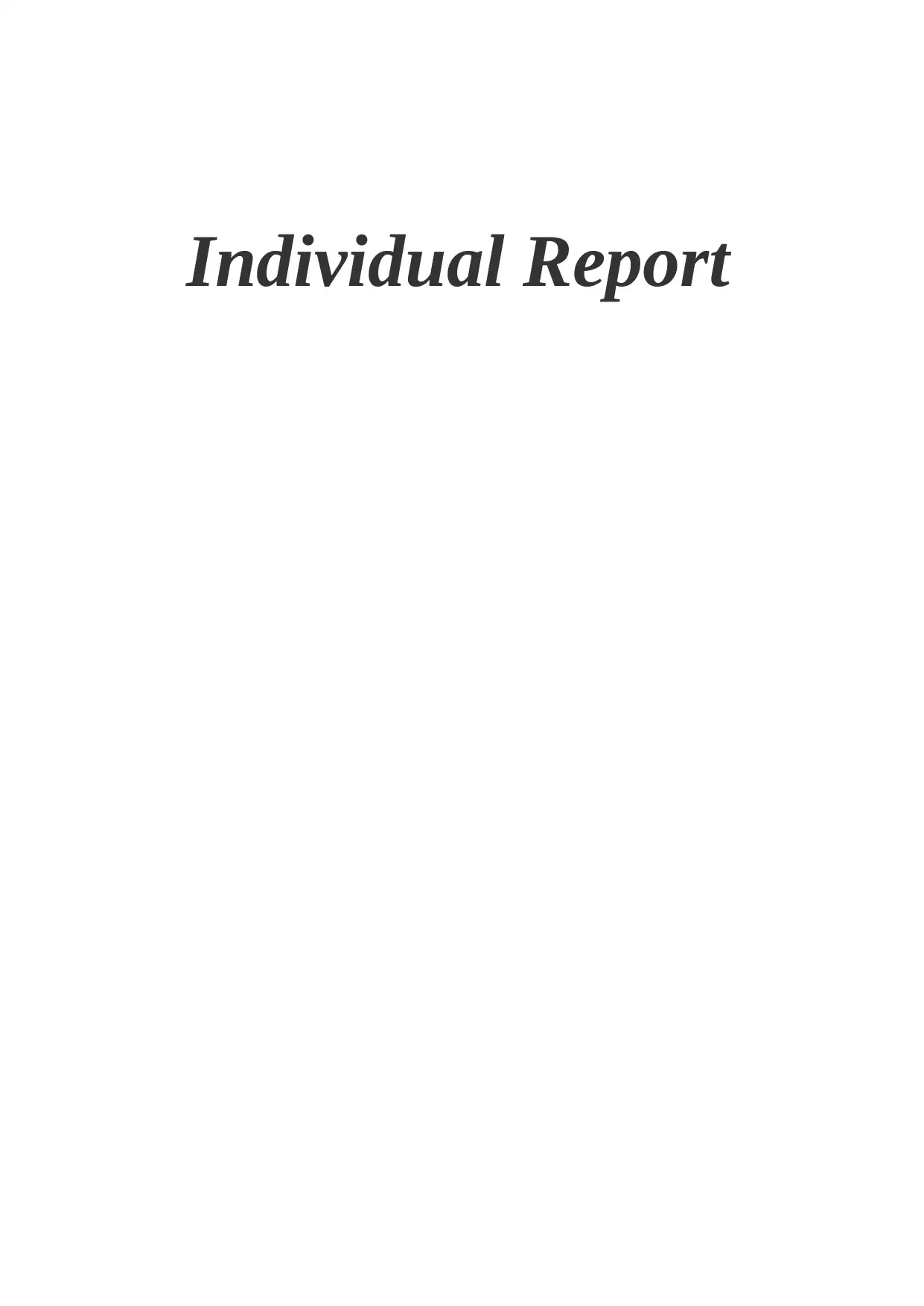
Individual Report
Paraphrase This Document
Need a fresh take? Get an instant paraphrase of this document with our AI Paraphraser
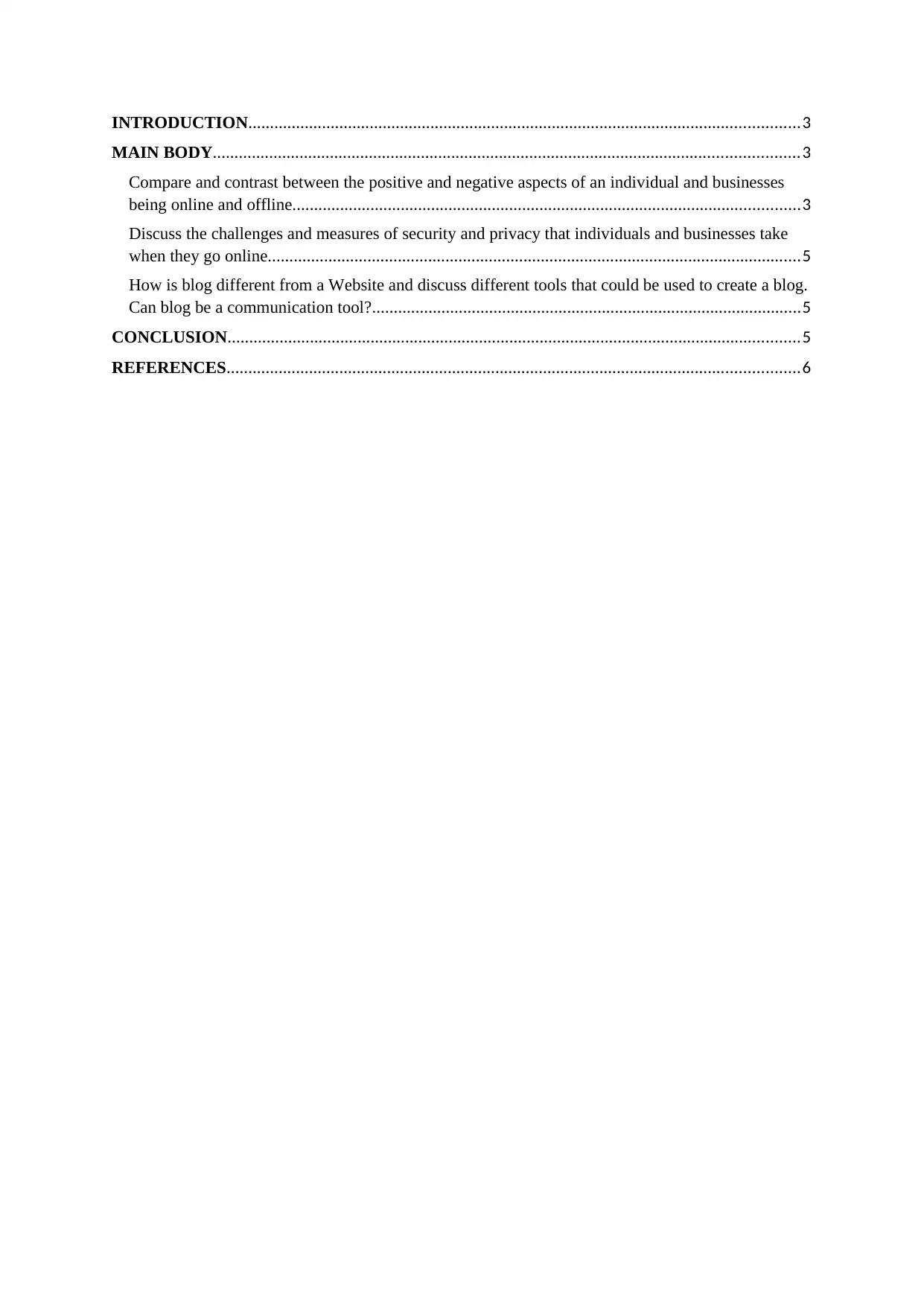
INTRODUCTION...............................................................................................................................3
MAIN BODY.......................................................................................................................................3
Compare and contrast between the positive and negative aspects of an individual and businesses
being online and offline.....................................................................................................................3
Discuss the challenges and measures of security and privacy that individuals and businesses take
when they go online...........................................................................................................................5
How is blog different from a Website and discuss different tools that could be used to create a blog.
Can blog be a communication tool?...................................................................................................5
CONCLUSION....................................................................................................................................5
REFERENCES....................................................................................................................................6
MAIN BODY.......................................................................................................................................3
Compare and contrast between the positive and negative aspects of an individual and businesses
being online and offline.....................................................................................................................3
Discuss the challenges and measures of security and privacy that individuals and businesses take
when they go online...........................................................................................................................5
How is blog different from a Website and discuss different tools that could be used to create a blog.
Can blog be a communication tool?...................................................................................................5
CONCLUSION....................................................................................................................................5
REFERENCES....................................................................................................................................6
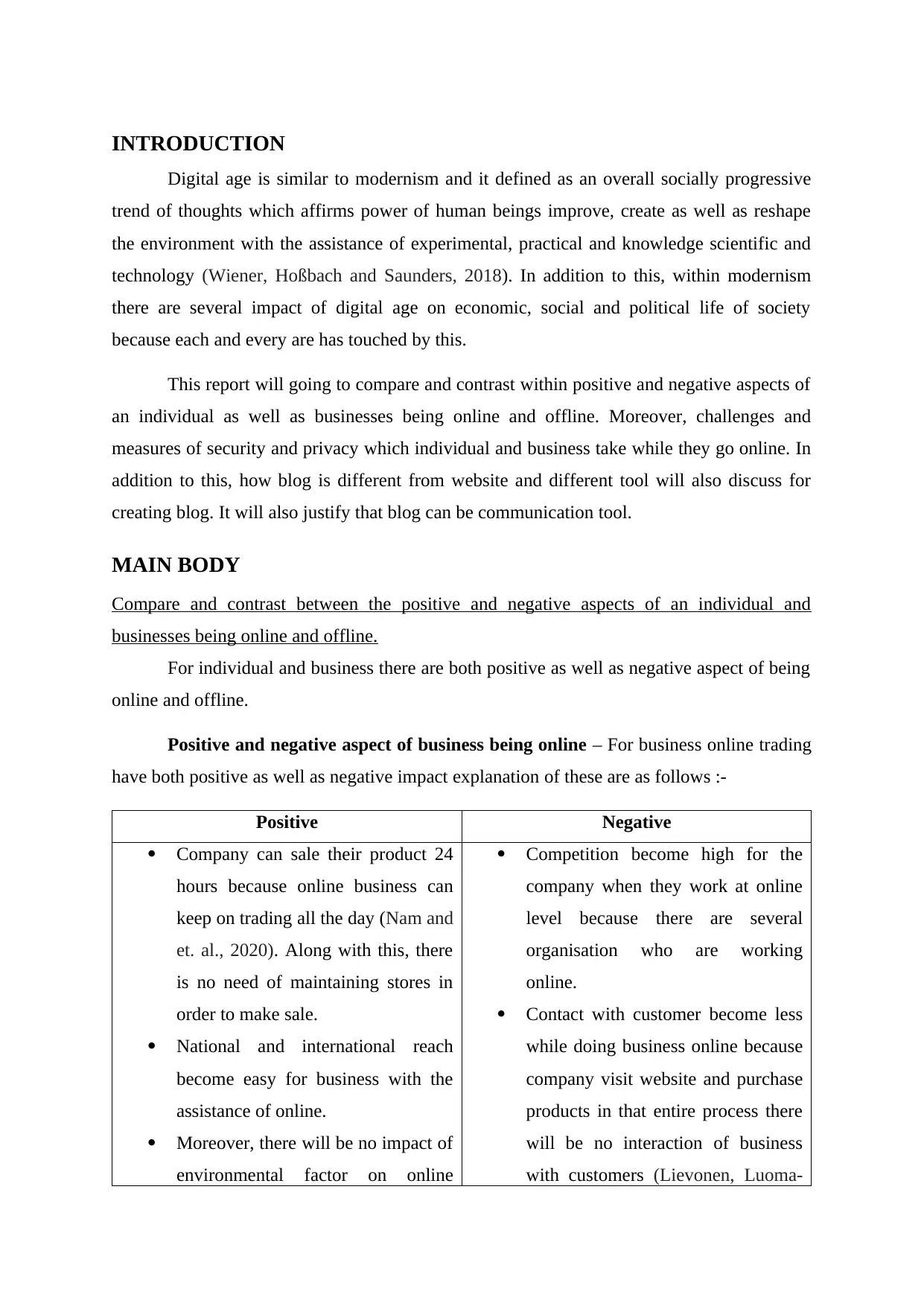
INTRODUCTION
Digital age is similar to modernism and it defined as an overall socially progressive
trend of thoughts which affirms power of human beings improve, create as well as reshape
the environment with the assistance of experimental, practical and knowledge scientific and
technology (Wiener, Hoßbach and Saunders, 2018). In addition to this, within modernism
there are several impact of digital age on economic, social and political life of society
because each and every are has touched by this.
This report will going to compare and contrast within positive and negative aspects of
an individual as well as businesses being online and offline. Moreover, challenges and
measures of security and privacy which individual and business take while they go online. In
addition to this, how blog is different from website and different tool will also discuss for
creating blog. It will also justify that blog can be communication tool.
MAIN BODY
Compare and contrast between the positive and negative aspects of an individual and
businesses being online and offline.
For individual and business there are both positive as well as negative aspect of being
online and offline.
Positive and negative aspect of business being online – For business online trading
have both positive as well as negative impact explanation of these are as follows :-
Positive Negative
Company can sale their product 24
hours because online business can
keep on trading all the day (Nam and
et. al., 2020). Along with this, there
is no need of maintaining stores in
order to make sale.
National and international reach
become easy for business with the
assistance of online.
Moreover, there will be no impact of
environmental factor on online
Competition become high for the
company when they work at online
level because there are several
organisation who are working
online.
Contact with customer become less
while doing business online because
company visit website and purchase
products in that entire process there
will be no interaction of business
with customers (Lievonen, Luoma-
Digital age is similar to modernism and it defined as an overall socially progressive
trend of thoughts which affirms power of human beings improve, create as well as reshape
the environment with the assistance of experimental, practical and knowledge scientific and
technology (Wiener, Hoßbach and Saunders, 2018). In addition to this, within modernism
there are several impact of digital age on economic, social and political life of society
because each and every are has touched by this.
This report will going to compare and contrast within positive and negative aspects of
an individual as well as businesses being online and offline. Moreover, challenges and
measures of security and privacy which individual and business take while they go online. In
addition to this, how blog is different from website and different tool will also discuss for
creating blog. It will also justify that blog can be communication tool.
MAIN BODY
Compare and contrast between the positive and negative aspects of an individual and
businesses being online and offline.
For individual and business there are both positive as well as negative aspect of being
online and offline.
Positive and negative aspect of business being online – For business online trading
have both positive as well as negative impact explanation of these are as follows :-
Positive Negative
Company can sale their product 24
hours because online business can
keep on trading all the day (Nam and
et. al., 2020). Along with this, there
is no need of maintaining stores in
order to make sale.
National and international reach
become easy for business with the
assistance of online.
Moreover, there will be no impact of
environmental factor on online
Competition become high for the
company when they work at online
level because there are several
organisation who are working
online.
Contact with customer become less
while doing business online because
company visit website and purchase
products in that entire process there
will be no interaction of business
with customers (Lievonen, Luoma-
⊘ This is a preview!⊘
Do you want full access?
Subscribe today to unlock all pages.

Trusted by 1+ million students worldwide
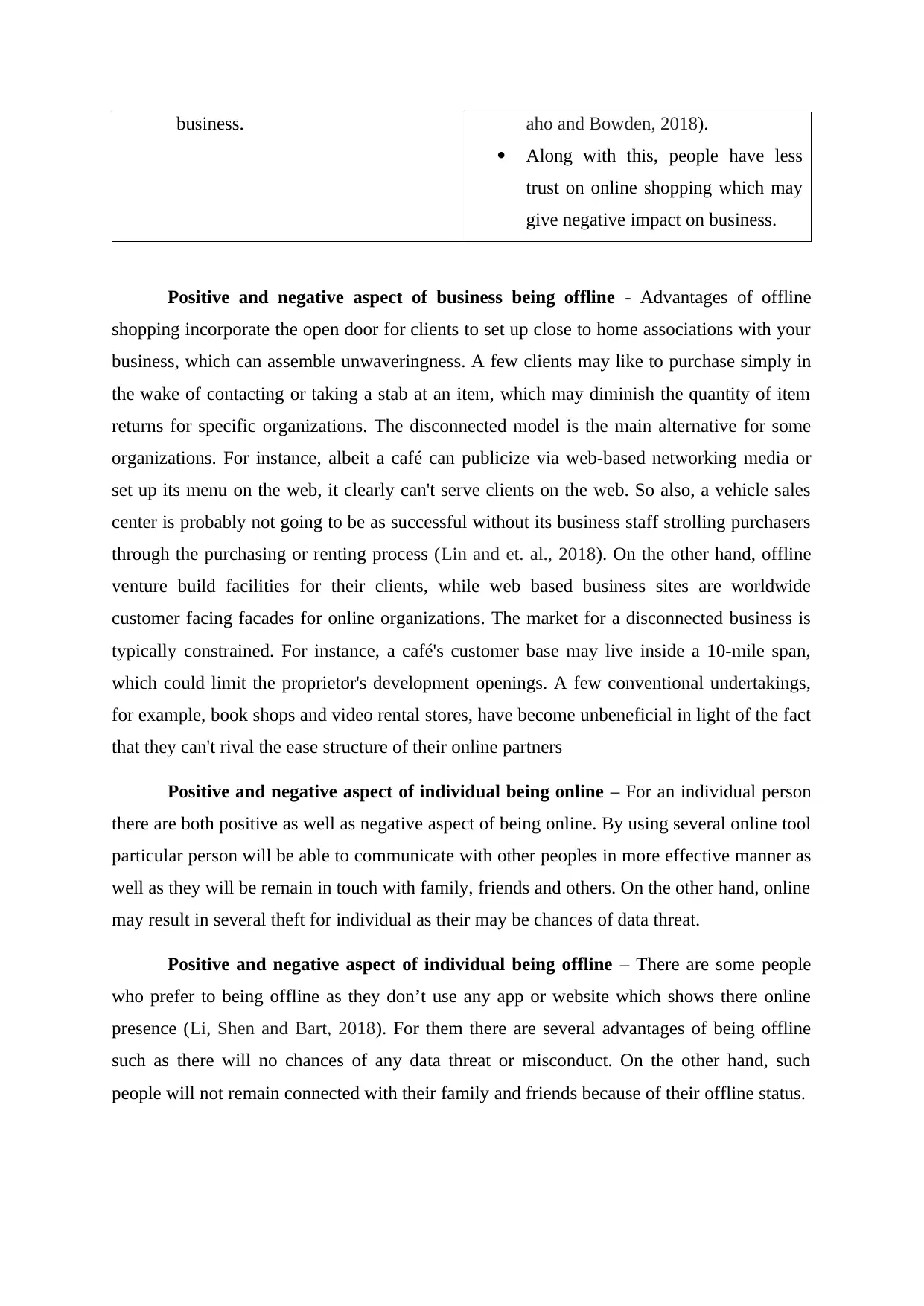
business. aho and Bowden, 2018).
Along with this, people have less
trust on online shopping which may
give negative impact on business.
Positive and negative aspect of business being offline - Advantages of offline
shopping incorporate the open door for clients to set up close to home associations with your
business, which can assemble unwaveringness. A few clients may like to purchase simply in
the wake of contacting or taking a stab at an item, which may diminish the quantity of item
returns for specific organizations. The disconnected model is the main alternative for some
organizations. For instance, albeit a café can publicize via web-based networking media or
set up its menu on the web, it clearly can't serve clients on the web. So also, a vehicle sales
center is probably not going to be as successful without its business staff strolling purchasers
through the purchasing or renting process (Lin and et. al., 2018). On the other hand, offline
venture build facilities for their clients, while web based business sites are worldwide
customer facing facades for online organizations. The market for a disconnected business is
typically constrained. For instance, a café's customer base may live inside a 10-mile span,
which could limit the proprietor's development openings. A few conventional undertakings,
for example, book shops and video rental stores, have become unbeneficial in light of the fact
that they can't rival the ease structure of their online partners
Positive and negative aspect of individual being online – For an individual person
there are both positive as well as negative aspect of being online. By using several online tool
particular person will be able to communicate with other peoples in more effective manner as
well as they will be remain in touch with family, friends and others. On the other hand, online
may result in several theft for individual as their may be chances of data threat.
Positive and negative aspect of individual being offline – There are some people
who prefer to being offline as they don’t use any app or website which shows there online
presence (Li, Shen and Bart, 2018). For them there are several advantages of being offline
such as there will no chances of any data threat or misconduct. On the other hand, such
people will not remain connected with their family and friends because of their offline status.
Along with this, people have less
trust on online shopping which may
give negative impact on business.
Positive and negative aspect of business being offline - Advantages of offline
shopping incorporate the open door for clients to set up close to home associations with your
business, which can assemble unwaveringness. A few clients may like to purchase simply in
the wake of contacting or taking a stab at an item, which may diminish the quantity of item
returns for specific organizations. The disconnected model is the main alternative for some
organizations. For instance, albeit a café can publicize via web-based networking media or
set up its menu on the web, it clearly can't serve clients on the web. So also, a vehicle sales
center is probably not going to be as successful without its business staff strolling purchasers
through the purchasing or renting process (Lin and et. al., 2018). On the other hand, offline
venture build facilities for their clients, while web based business sites are worldwide
customer facing facades for online organizations. The market for a disconnected business is
typically constrained. For instance, a café's customer base may live inside a 10-mile span,
which could limit the proprietor's development openings. A few conventional undertakings,
for example, book shops and video rental stores, have become unbeneficial in light of the fact
that they can't rival the ease structure of their online partners
Positive and negative aspect of individual being online – For an individual person
there are both positive as well as negative aspect of being online. By using several online tool
particular person will be able to communicate with other peoples in more effective manner as
well as they will be remain in touch with family, friends and others. On the other hand, online
may result in several theft for individual as their may be chances of data threat.
Positive and negative aspect of individual being offline – There are some people
who prefer to being offline as they don’t use any app or website which shows there online
presence (Li, Shen and Bart, 2018). For them there are several advantages of being offline
such as there will no chances of any data threat or misconduct. On the other hand, such
people will not remain connected with their family and friends because of their offline status.
Paraphrase This Document
Need a fresh take? Get an instant paraphrase of this document with our AI Paraphraser
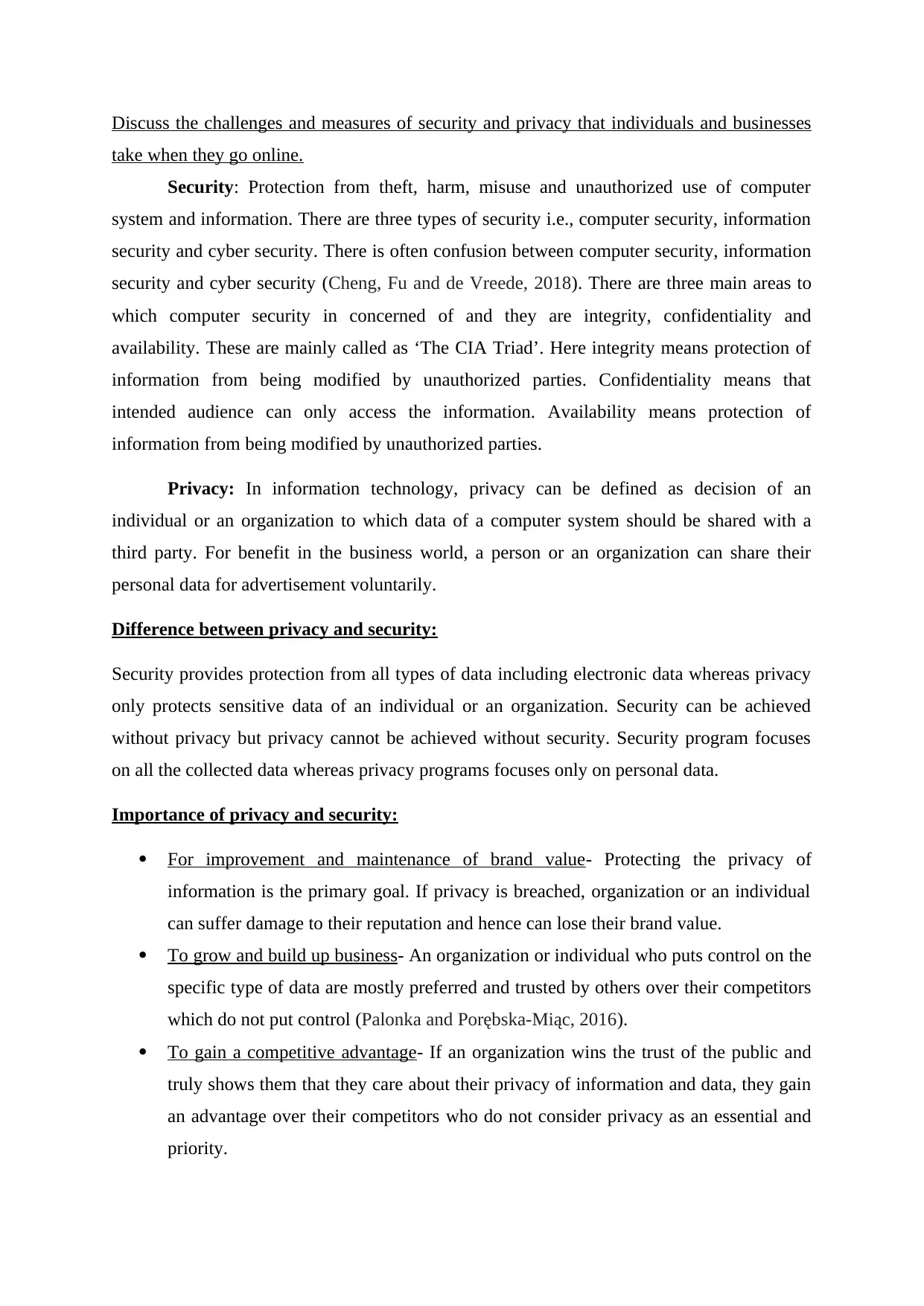
Discuss the challenges and measures of security and privacy that individuals and businesses
take when they go online.
Security: Protection from theft, harm, misuse and unauthorized use of computer
system and information. There are three types of security i.e., computer security, information
security and cyber security. There is often confusion between computer security, information
security and cyber security (Cheng, Fu and de Vreede, 2018). There are three main areas to
which computer security in concerned of and they are integrity, confidentiality and
availability. These are mainly called as ‘The CIA Triad’. Here integrity means protection of
information from being modified by unauthorized parties. Confidentiality means that
intended audience can only access the information. Availability means protection of
information from being modified by unauthorized parties.
Privacy: In information technology, privacy can be defined as decision of an
individual or an organization to which data of a computer system should be shared with a
third party. For benefit in the business world, a person or an organization can share their
personal data for advertisement voluntarily.
Difference between privacy and security:
Security provides protection from all types of data including electronic data whereas privacy
only protects sensitive data of an individual or an organization. Security can be achieved
without privacy but privacy cannot be achieved without security. Security program focuses
on all the collected data whereas privacy programs focuses only on personal data.
Importance of privacy and security:
For improvement and maintenance of brand value- Protecting the privacy of
information is the primary goal. If privacy is breached, organization or an individual
can suffer damage to their reputation and hence can lose their brand value.
To grow and build up business- An organization or individual who puts control on the
specific type of data are mostly preferred and trusted by others over their competitors
which do not put control (Palonka and Porębska-Miąc, 2016).
To gain a competitive advantage- If an organization wins the trust of the public and
truly shows them that they care about their privacy of information and data, they gain
an advantage over their competitors who do not consider privacy as an essential and
priority.
take when they go online.
Security: Protection from theft, harm, misuse and unauthorized use of computer
system and information. There are three types of security i.e., computer security, information
security and cyber security. There is often confusion between computer security, information
security and cyber security (Cheng, Fu and de Vreede, 2018). There are three main areas to
which computer security in concerned of and they are integrity, confidentiality and
availability. These are mainly called as ‘The CIA Triad’. Here integrity means protection of
information from being modified by unauthorized parties. Confidentiality means that
intended audience can only access the information. Availability means protection of
information from being modified by unauthorized parties.
Privacy: In information technology, privacy can be defined as decision of an
individual or an organization to which data of a computer system should be shared with a
third party. For benefit in the business world, a person or an organization can share their
personal data for advertisement voluntarily.
Difference between privacy and security:
Security provides protection from all types of data including electronic data whereas privacy
only protects sensitive data of an individual or an organization. Security can be achieved
without privacy but privacy cannot be achieved without security. Security program focuses
on all the collected data whereas privacy programs focuses only on personal data.
Importance of privacy and security:
For improvement and maintenance of brand value- Protecting the privacy of
information is the primary goal. If privacy is breached, organization or an individual
can suffer damage to their reputation and hence can lose their brand value.
To grow and build up business- An organization or individual who puts control on the
specific type of data are mostly preferred and trusted by others over their competitors
which do not put control (Palonka and Porębska-Miąc, 2016).
To gain a competitive advantage- If an organization wins the trust of the public and
truly shows them that they care about their privacy of information and data, they gain
an advantage over their competitors who do not consider privacy as an essential and
priority.
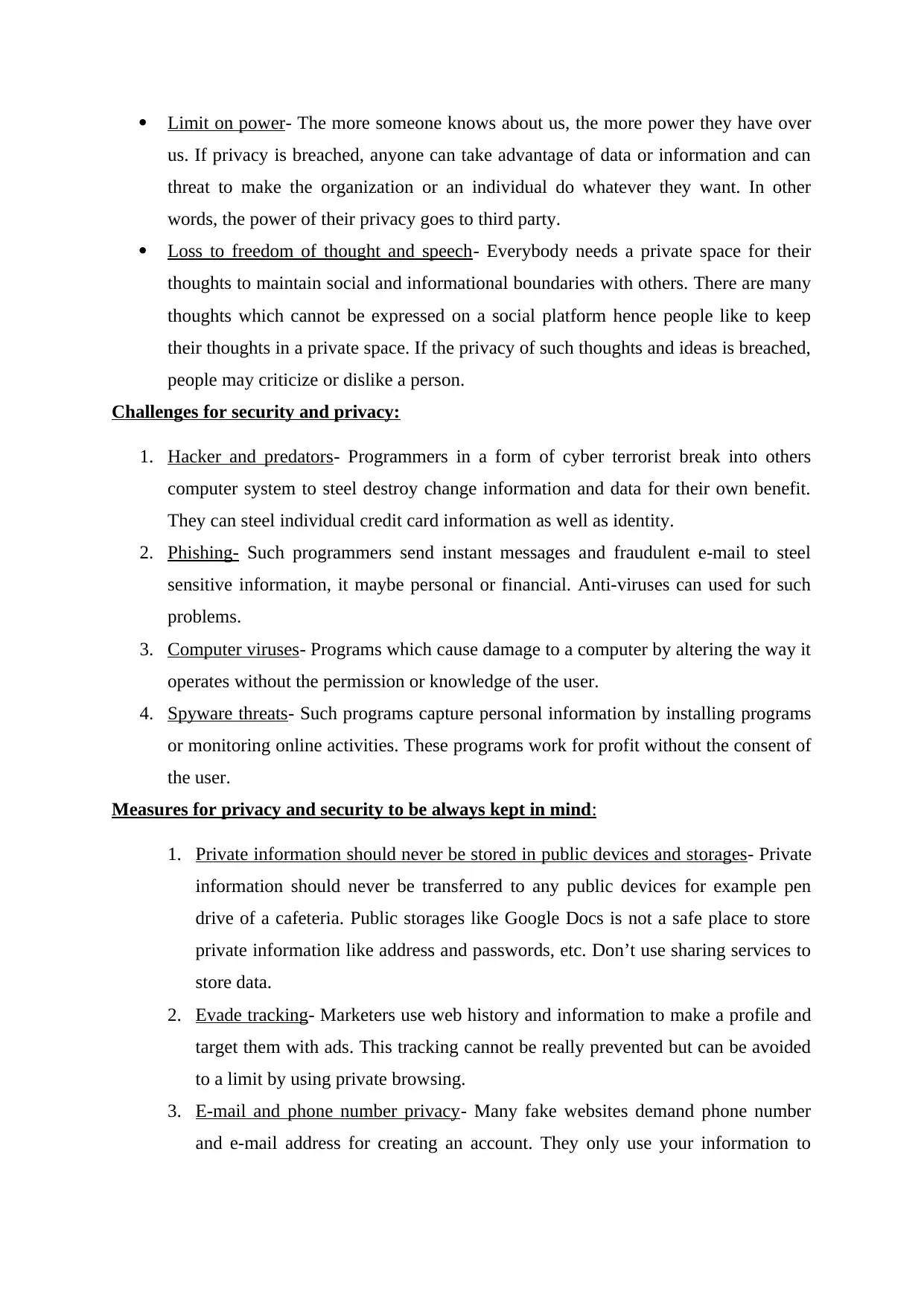
Limit on power- The more someone knows about us, the more power they have over
us. If privacy is breached, anyone can take advantage of data or information and can
threat to make the organization or an individual do whatever they want. In other
words, the power of their privacy goes to third party.
Loss to freedom of thought and speech- Everybody needs a private space for their
thoughts to maintain social and informational boundaries with others. There are many
thoughts which cannot be expressed on a social platform hence people like to keep
their thoughts in a private space. If the privacy of such thoughts and ideas is breached,
people may criticize or dislike a person.
Challenges for security and privacy:
1. Hacker and predators- Programmers in a form of cyber terrorist break into others
computer system to steel destroy change information and data for their own benefit.
They can steel individual credit card information as well as identity.
2. Phishing- Such programmers send instant messages and fraudulent e-mail to steel
sensitive information, it maybe personal or financial. Anti-viruses can used for such
problems.
3. Computer viruses- Programs which cause damage to a computer by altering the way it
operates without the permission or knowledge of the user.
4. Spyware threats- Such programs capture personal information by installing programs
or monitoring online activities. These programs work for profit without the consent of
the user.
Measures for privacy and security to be always kept in mind:
1. Private information should never be stored in public devices and storages- Private
information should never be transferred to any public devices for example pen
drive of a cafeteria. Public storages like Google Docs is not a safe place to store
private information like address and passwords, etc. Don’t use sharing services to
store data.
2. Evade tracking- Marketers use web history and information to make a profile and
target them with ads. This tracking cannot be really prevented but can be avoided
to a limit by using private browsing.
3. E-mail and phone number privacy- Many fake websites demand phone number
and e-mail address for creating an account. They only use your information to
us. If privacy is breached, anyone can take advantage of data or information and can
threat to make the organization or an individual do whatever they want. In other
words, the power of their privacy goes to third party.
Loss to freedom of thought and speech- Everybody needs a private space for their
thoughts to maintain social and informational boundaries with others. There are many
thoughts which cannot be expressed on a social platform hence people like to keep
their thoughts in a private space. If the privacy of such thoughts and ideas is breached,
people may criticize or dislike a person.
Challenges for security and privacy:
1. Hacker and predators- Programmers in a form of cyber terrorist break into others
computer system to steel destroy change information and data for their own benefit.
They can steel individual credit card information as well as identity.
2. Phishing- Such programmers send instant messages and fraudulent e-mail to steel
sensitive information, it maybe personal or financial. Anti-viruses can used for such
problems.
3. Computer viruses- Programs which cause damage to a computer by altering the way it
operates without the permission or knowledge of the user.
4. Spyware threats- Such programs capture personal information by installing programs
or monitoring online activities. These programs work for profit without the consent of
the user.
Measures for privacy and security to be always kept in mind:
1. Private information should never be stored in public devices and storages- Private
information should never be transferred to any public devices for example pen
drive of a cafeteria. Public storages like Google Docs is not a safe place to store
private information like address and passwords, etc. Don’t use sharing services to
store data.
2. Evade tracking- Marketers use web history and information to make a profile and
target them with ads. This tracking cannot be really prevented but can be avoided
to a limit by using private browsing.
3. E-mail and phone number privacy- Many fake websites demand phone number
and e-mail address for creating an account. They only use your information to
⊘ This is a preview!⊘
Do you want full access?
Subscribe today to unlock all pages.

Trusted by 1+ million students worldwide
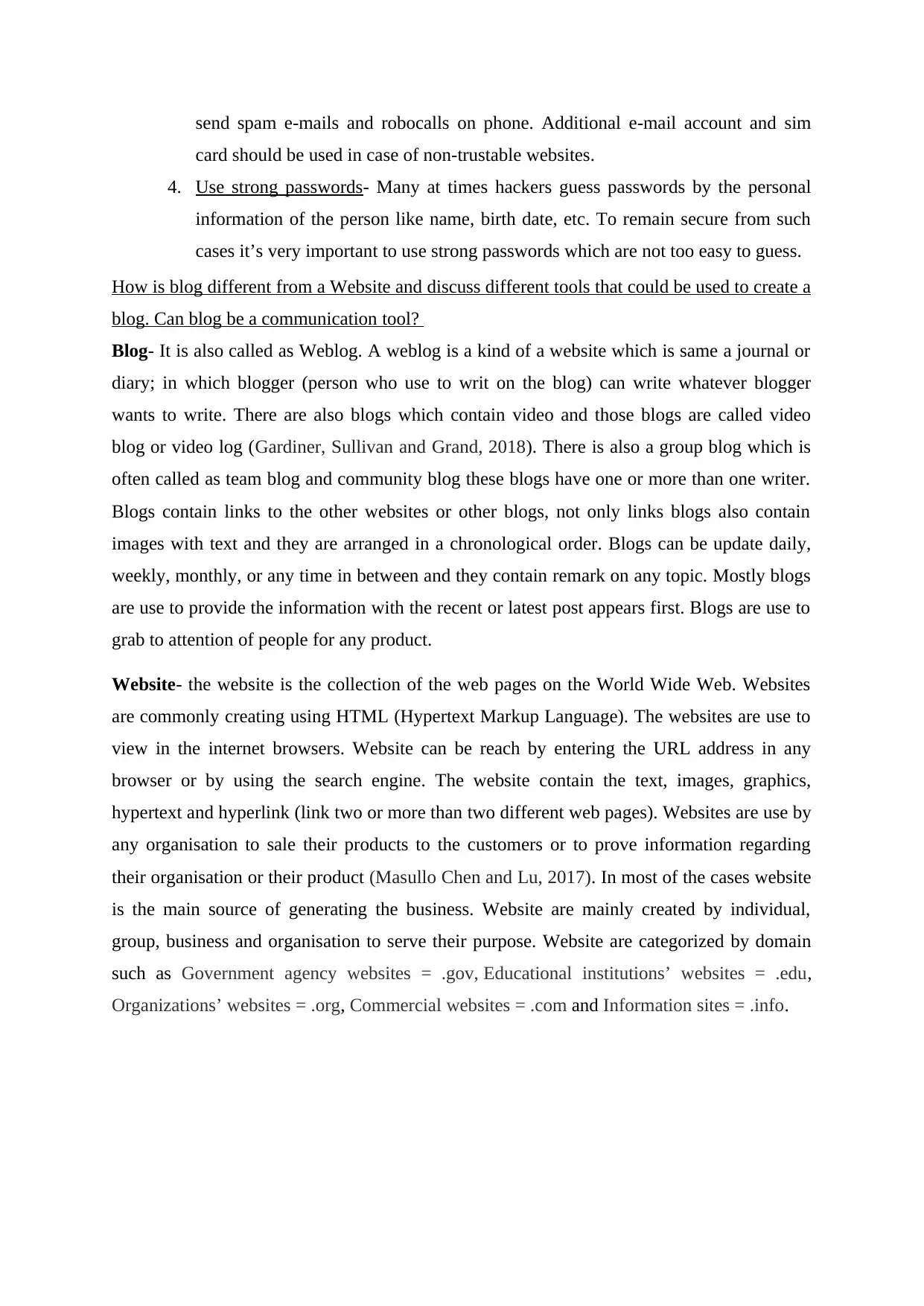
send spam e-mails and robocalls on phone. Additional e-mail account and sim
card should be used in case of non-trustable websites.
4. Use strong passwords- Many at times hackers guess passwords by the personal
information of the person like name, birth date, etc. To remain secure from such
cases it’s very important to use strong passwords which are not too easy to guess.
How is blog different from a Website and discuss different tools that could be used to create a
blog. Can blog be a communication tool?
Blog- It is also called as Weblog. A weblog is a kind of a website which is same a journal or
diary; in which blogger (person who use to writ on the blog) can write whatever blogger
wants to write. There are also blogs which contain video and those blogs are called video
blog or video log (Gardiner, Sullivan and Grand, 2018). There is also a group blog which is
often called as team blog and community blog these blogs have one or more than one writer.
Blogs contain links to the other websites or other blogs, not only links blogs also contain
images with text and they are arranged in a chronological order. Blogs can be update daily,
weekly, monthly, or any time in between and they contain remark on any topic. Mostly blogs
are use to provide the information with the recent or latest post appears first. Blogs are use to
grab to attention of people for any product.
Website- the website is the collection of the web pages on the World Wide Web. Websites
are commonly creating using HTML (Hypertext Markup Language). The websites are use to
view in the internet browsers. Website can be reach by entering the URL address in any
browser or by using the search engine. The website contain the text, images, graphics,
hypertext and hyperlink (link two or more than two different web pages). Websites are use by
any organisation to sale their products to the customers or to prove information regarding
their organisation or their product (Masullo Chen and Lu, 2017). In most of the cases website
is the main source of generating the business. Website are mainly created by individual,
group, business and organisation to serve their purpose. Website are categorized by domain
such as Government agency websites = .gov, Educational institutions’ websites = .edu,
Organizations’ websites = .org, Commercial websites = .com and Information sites = .info.
card should be used in case of non-trustable websites.
4. Use strong passwords- Many at times hackers guess passwords by the personal
information of the person like name, birth date, etc. To remain secure from such
cases it’s very important to use strong passwords which are not too easy to guess.
How is blog different from a Website and discuss different tools that could be used to create a
blog. Can blog be a communication tool?
Blog- It is also called as Weblog. A weblog is a kind of a website which is same a journal or
diary; in which blogger (person who use to writ on the blog) can write whatever blogger
wants to write. There are also blogs which contain video and those blogs are called video
blog or video log (Gardiner, Sullivan and Grand, 2018). There is also a group blog which is
often called as team blog and community blog these blogs have one or more than one writer.
Blogs contain links to the other websites or other blogs, not only links blogs also contain
images with text and they are arranged in a chronological order. Blogs can be update daily,
weekly, monthly, or any time in between and they contain remark on any topic. Mostly blogs
are use to provide the information with the recent or latest post appears first. Blogs are use to
grab to attention of people for any product.
Website- the website is the collection of the web pages on the World Wide Web. Websites
are commonly creating using HTML (Hypertext Markup Language). The websites are use to
view in the internet browsers. Website can be reach by entering the URL address in any
browser or by using the search engine. The website contain the text, images, graphics,
hypertext and hyperlink (link two or more than two different web pages). Websites are use by
any organisation to sale their products to the customers or to prove information regarding
their organisation or their product (Masullo Chen and Lu, 2017). In most of the cases website
is the main source of generating the business. Website are mainly created by individual,
group, business and organisation to serve their purpose. Website are categorized by domain
such as Government agency websites = .gov, Educational institutions’ websites = .edu,
Organizations’ websites = .org, Commercial websites = .com and Information sites = .info.
Paraphrase This Document
Need a fresh take? Get an instant paraphrase of this document with our AI Paraphraser
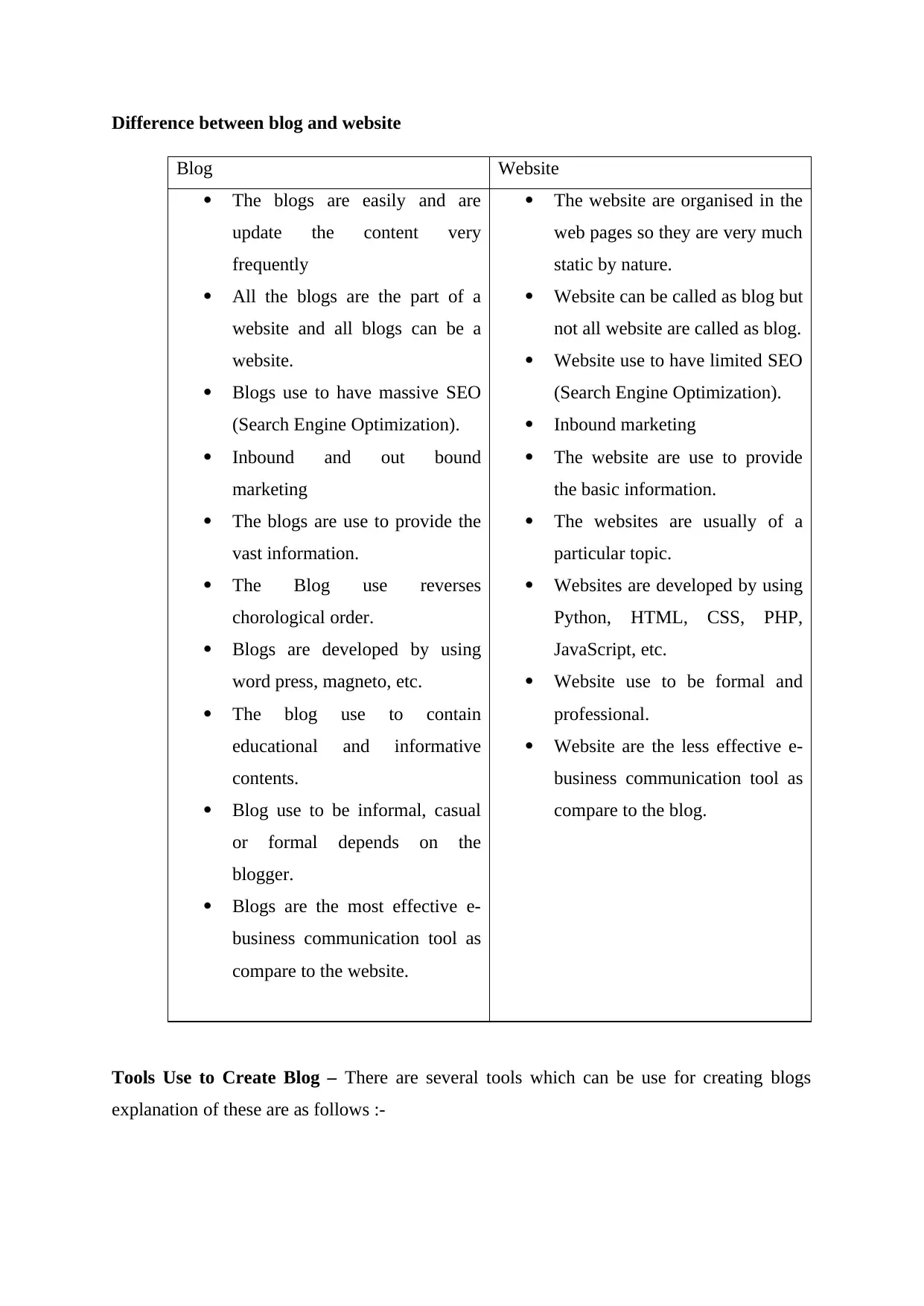
Difference between blog and website
Blog Website
The blogs are easily and are
update the content very
frequently
All the blogs are the part of a
website and all blogs can be a
website.
Blogs use to have massive SEO
(Search Engine Optimization).
Inbound and out bound
marketing
The blogs are use to provide the
vast information.
The Blog use reverses
chorological order.
Blogs are developed by using
word press, magneto, etc.
The blog use to contain
educational and informative
contents.
Blog use to be informal, casual
or formal depends on the
blogger.
Blogs are the most effective e-
business communication tool as
compare to the website.
The website are organised in the
web pages so they are very much
static by nature.
Website can be called as blog but
not all website are called as blog.
Website use to have limited SEO
(Search Engine Optimization).
Inbound marketing
The website are use to provide
the basic information.
The websites are usually of a
particular topic.
Websites are developed by using
Python, HTML, CSS, PHP,
JavaScript, etc.
Website use to be formal and
professional.
Website are the less effective e-
business communication tool as
compare to the blog.
Tools Use to Create Blog – There are several tools which can be use for creating blogs
explanation of these are as follows :-
Blog Website
The blogs are easily and are
update the content very
frequently
All the blogs are the part of a
website and all blogs can be a
website.
Blogs use to have massive SEO
(Search Engine Optimization).
Inbound and out bound
marketing
The blogs are use to provide the
vast information.
The Blog use reverses
chorological order.
Blogs are developed by using
word press, magneto, etc.
The blog use to contain
educational and informative
contents.
Blog use to be informal, casual
or formal depends on the
blogger.
Blogs are the most effective e-
business communication tool as
compare to the website.
The website are organised in the
web pages so they are very much
static by nature.
Website can be called as blog but
not all website are called as blog.
Website use to have limited SEO
(Search Engine Optimization).
Inbound marketing
The website are use to provide
the basic information.
The websites are usually of a
particular topic.
Websites are developed by using
Python, HTML, CSS, PHP,
JavaScript, etc.
Website use to be formal and
professional.
Website are the less effective e-
business communication tool as
compare to the blog.
Tools Use to Create Blog – There are several tools which can be use for creating blogs
explanation of these are as follows :-
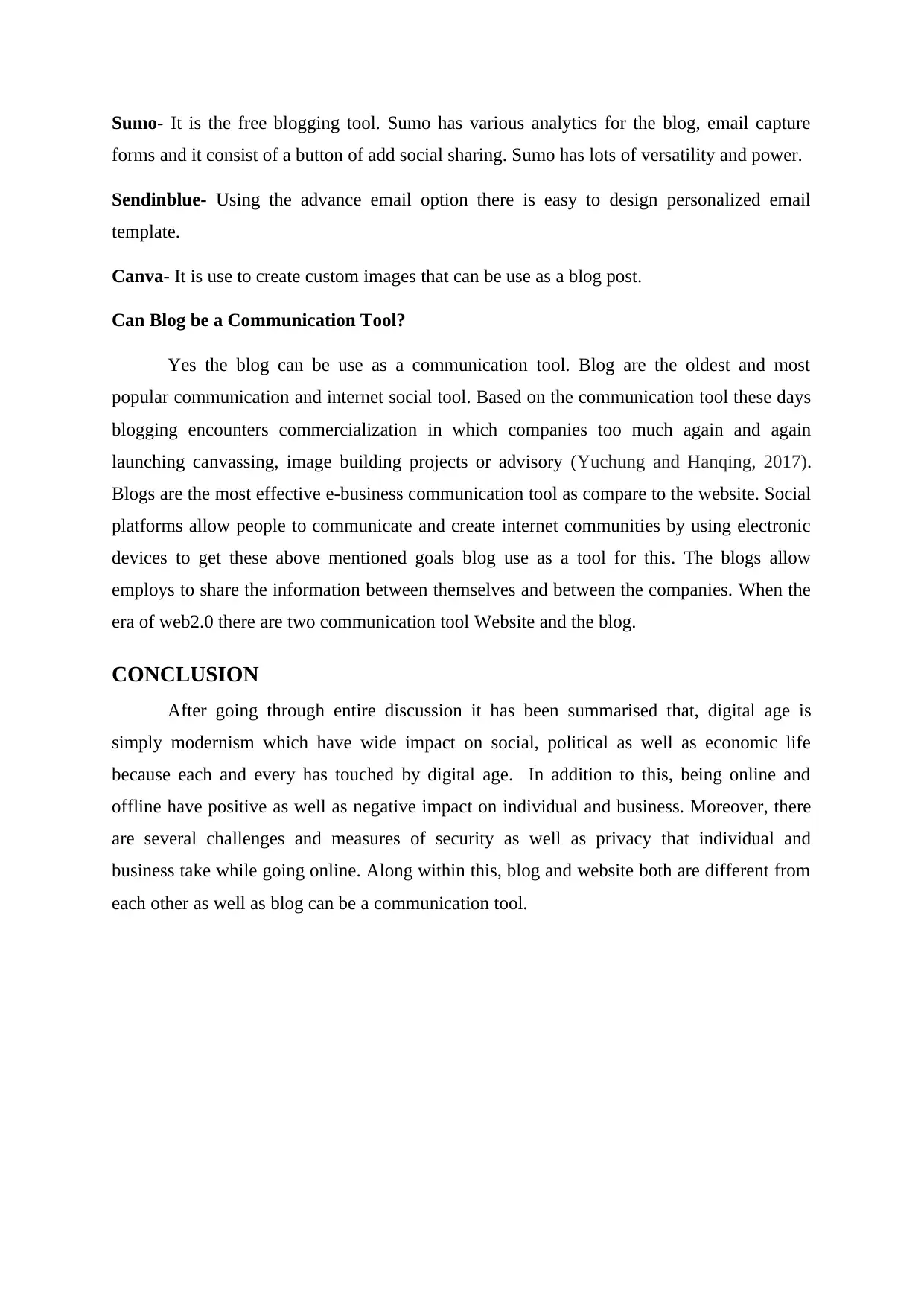
Sumo- It is the free blogging tool. Sumo has various analytics for the blog, email capture
forms and it consist of a button of add social sharing. Sumo has lots of versatility and power.
Sendinblue- Using the advance email option there is easy to design personalized email
template.
Canva- It is use to create custom images that can be use as a blog post.
Can Blog be a Communication Tool?
Yes the blog can be use as a communication tool. Blog are the oldest and most
popular communication and internet social tool. Based on the communication tool these days
blogging encounters commercialization in which companies too much again and again
launching canvassing, image building projects or advisory (Yuchung and Hanqing, 2017).
Blogs are the most effective e-business communication tool as compare to the website. Social
platforms allow people to communicate and create internet communities by using electronic
devices to get these above mentioned goals blog use as a tool for this. The blogs allow
employs to share the information between themselves and between the companies. When the
era of web2.0 there are two communication tool Website and the blog.
CONCLUSION
After going through entire discussion it has been summarised that, digital age is
simply modernism which have wide impact on social, political as well as economic life
because each and every has touched by digital age. In addition to this, being online and
offline have positive as well as negative impact on individual and business. Moreover, there
are several challenges and measures of security as well as privacy that individual and
business take while going online. Along within this, blog and website both are different from
each other as well as blog can be a communication tool.
forms and it consist of a button of add social sharing. Sumo has lots of versatility and power.
Sendinblue- Using the advance email option there is easy to design personalized email
template.
Canva- It is use to create custom images that can be use as a blog post.
Can Blog be a Communication Tool?
Yes the blog can be use as a communication tool. Blog are the oldest and most
popular communication and internet social tool. Based on the communication tool these days
blogging encounters commercialization in which companies too much again and again
launching canvassing, image building projects or advisory (Yuchung and Hanqing, 2017).
Blogs are the most effective e-business communication tool as compare to the website. Social
platforms allow people to communicate and create internet communities by using electronic
devices to get these above mentioned goals blog use as a tool for this. The blogs allow
employs to share the information between themselves and between the companies. When the
era of web2.0 there are two communication tool Website and the blog.
CONCLUSION
After going through entire discussion it has been summarised that, digital age is
simply modernism which have wide impact on social, political as well as economic life
because each and every has touched by digital age. In addition to this, being online and
offline have positive as well as negative impact on individual and business. Moreover, there
are several challenges and measures of security as well as privacy that individual and
business take while going online. Along within this, blog and website both are different from
each other as well as blog can be a communication tool.
⊘ This is a preview!⊘
Do you want full access?
Subscribe today to unlock all pages.

Trusted by 1+ million students worldwide
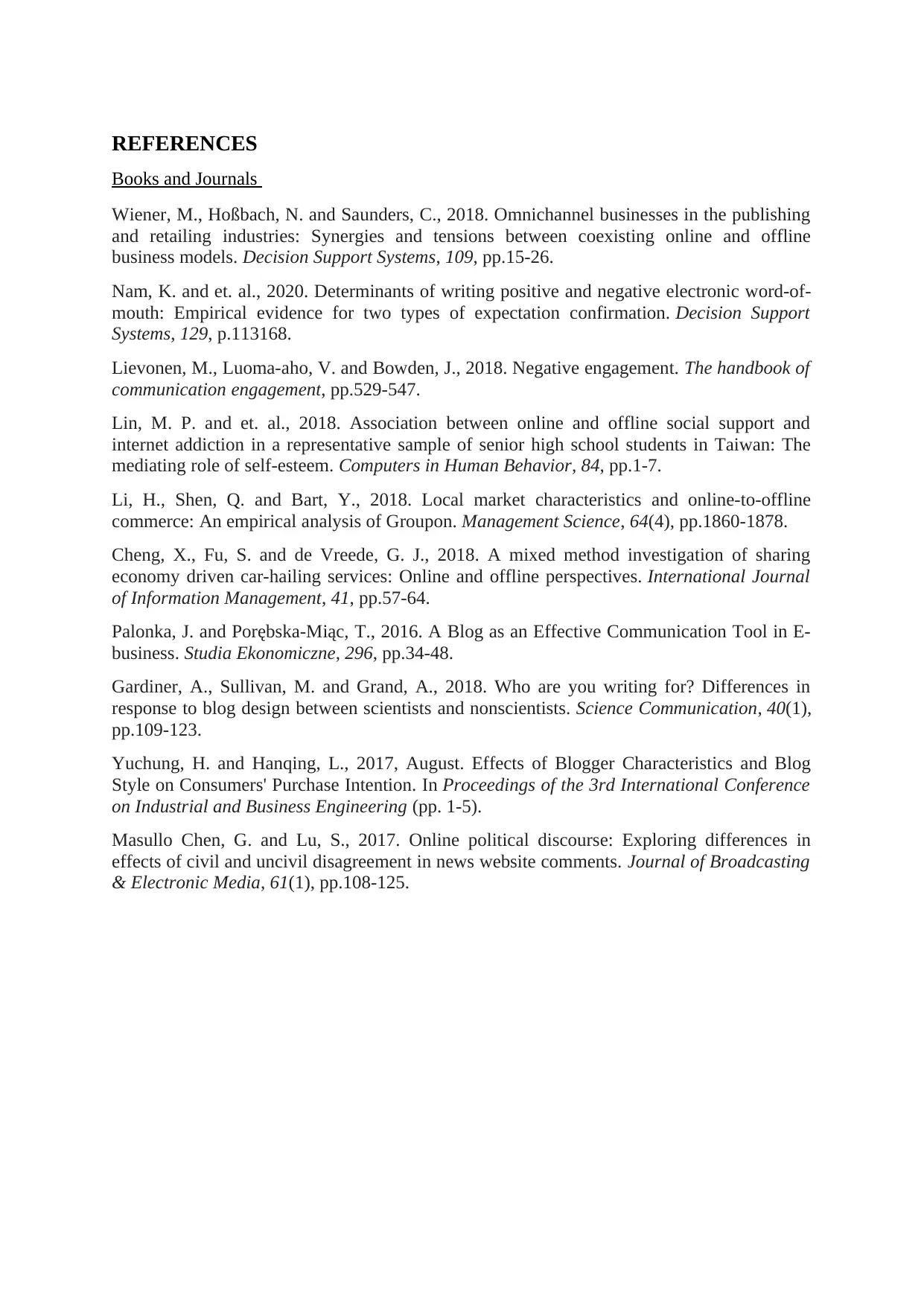
REFERENCES
Books and Journals
Wiener, M., Hoßbach, N. and Saunders, C., 2018. Omnichannel businesses in the publishing
and retailing industries: Synergies and tensions between coexisting online and offline
business models. Decision Support Systems, 109, pp.15-26.
Nam, K. and et. al., 2020. Determinants of writing positive and negative electronic word-of-
mouth: Empirical evidence for two types of expectation confirmation. Decision Support
Systems, 129, p.113168.
Lievonen, M., Luoma-aho, V. and Bowden, J., 2018. Negative engagement. The handbook of
communication engagement, pp.529-547.
Lin, M. P. and et. al., 2018. Association between online and offline social support and
internet addiction in a representative sample of senior high school students in Taiwan: The
mediating role of self-esteem. Computers in Human Behavior, 84, pp.1-7.
Li, H., Shen, Q. and Bart, Y., 2018. Local market characteristics and online-to-offline
commerce: An empirical analysis of Groupon. Management Science, 64(4), pp.1860-1878.
Cheng, X., Fu, S. and de Vreede, G. J., 2018. A mixed method investigation of sharing
economy driven car-hailing services: Online and offline perspectives. International Journal
of Information Management, 41, pp.57-64.
Palonka, J. and Porębska-Miąc, T., 2016. A Blog as an Effective Communication Tool in E-
business. Studia Ekonomiczne, 296, pp.34-48.
Gardiner, A., Sullivan, M. and Grand, A., 2018. Who are you writing for? Differences in
response to blog design between scientists and nonscientists. Science Communication, 40(1),
pp.109-123.
Yuchung, H. and Hanqing, L., 2017, August. Effects of Blogger Characteristics and Blog
Style on Consumers' Purchase Intention. In Proceedings of the 3rd International Conference
on Industrial and Business Engineering (pp. 1-5).
Masullo Chen, G. and Lu, S., 2017. Online political discourse: Exploring differences in
effects of civil and uncivil disagreement in news website comments. Journal of Broadcasting
& Electronic Media, 61(1), pp.108-125.
Books and Journals
Wiener, M., Hoßbach, N. and Saunders, C., 2018. Omnichannel businesses in the publishing
and retailing industries: Synergies and tensions between coexisting online and offline
business models. Decision Support Systems, 109, pp.15-26.
Nam, K. and et. al., 2020. Determinants of writing positive and negative electronic word-of-
mouth: Empirical evidence for two types of expectation confirmation. Decision Support
Systems, 129, p.113168.
Lievonen, M., Luoma-aho, V. and Bowden, J., 2018. Negative engagement. The handbook of
communication engagement, pp.529-547.
Lin, M. P. and et. al., 2018. Association between online and offline social support and
internet addiction in a representative sample of senior high school students in Taiwan: The
mediating role of self-esteem. Computers in Human Behavior, 84, pp.1-7.
Li, H., Shen, Q. and Bart, Y., 2018. Local market characteristics and online-to-offline
commerce: An empirical analysis of Groupon. Management Science, 64(4), pp.1860-1878.
Cheng, X., Fu, S. and de Vreede, G. J., 2018. A mixed method investigation of sharing
economy driven car-hailing services: Online and offline perspectives. International Journal
of Information Management, 41, pp.57-64.
Palonka, J. and Porębska-Miąc, T., 2016. A Blog as an Effective Communication Tool in E-
business. Studia Ekonomiczne, 296, pp.34-48.
Gardiner, A., Sullivan, M. and Grand, A., 2018. Who are you writing for? Differences in
response to blog design between scientists and nonscientists. Science Communication, 40(1),
pp.109-123.
Yuchung, H. and Hanqing, L., 2017, August. Effects of Blogger Characteristics and Blog
Style on Consumers' Purchase Intention. In Proceedings of the 3rd International Conference
on Industrial and Business Engineering (pp. 1-5).
Masullo Chen, G. and Lu, S., 2017. Online political discourse: Exploring differences in
effects of civil and uncivil disagreement in news website comments. Journal of Broadcasting
& Electronic Media, 61(1), pp.108-125.
1 out of 10
Related Documents
Your All-in-One AI-Powered Toolkit for Academic Success.
+13062052269
info@desklib.com
Available 24*7 on WhatsApp / Email
![[object Object]](/_next/static/media/star-bottom.7253800d.svg)
Unlock your academic potential
Copyright © 2020–2025 A2Z Services. All Rights Reserved. Developed and managed by ZUCOL.





